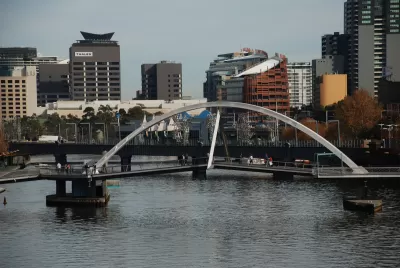Melbourne's long-range plan for development through 2050 envisions denser neighborhoods, built around the idea of 20-minute neighborhoods.

The Plan Melbourne 2017-2050 long-range plan released last week has offered some innovative changes to the city's current planning scheme to address an anticipated growth from 4.5 million to 8 million residents between now and 2050. The plan would remove current limitations that only permits two dwelling units per residentially zoned lot. Urban Development Institute of Australia Victorian CEO Danni Addison is supportive of the proposed density increases, noting that it will give middle- to low-income resident an opportunity to live in Melbourne's inner suburbs. John Masanauskas of the Herald Sunreports that the plan's detractors worry about the loss of the city's suburban character, losing its livability and becoming "a concrete jungle."
However, the plan has also introduced requirements for maintenance of minimum garden space for lots greater than 400 square meters (approx. 4,300 sq. ft), which has earned the support of residents who love their "Aussie backyard". The plan also seeks to create 20-minute neighborhoods that will allow residents to access basic needs within a 20-minute trip without the use of a car.
The concept involves reducing car use by encouraging more active modes of transport while creating mixed-use community areas of varying densities.
Under Plan Melbourne 2017-2050, people should be able to meet most of their everyday needs within a 20-minute walk, cycle or public transport trip from their home, but not including travel to work.
Each neighbourhood would have an activity centre with shops, cafes, service businesses and community hubs, while residents would also have access to local schools, sporting facilities and parks.
The Plan Melbourne 2017-2050 document can be found online, here.
FULL STORY: Andrews Government to force developers to offer minimum garden space under Plan Melbourne

Alabama: Trump Terminates Settlements for Black Communities Harmed By Raw Sewage
Trump deemed the landmark civil rights agreement “illegal DEI and environmental justice policy.”

Planetizen Federal Action Tracker
A weekly monitor of how Trump’s orders and actions are impacting planners and planning in America.

The 120 Year Old Tiny Home Villages That Sheltered San Francisco’s Earthquake Refugees
More than a century ago, San Francisco mobilized to house thousands of residents displaced by the 1906 earthquake. Could their strategy offer a model for the present?

San Francisco Opens Park on Former Great Highway
The Sunset Dunes park’s grand opening attracted both fans and detractors.

Oregon Legislature to Consider Transit Funding Laws
One proposal would increase the state’s payroll tax by .08% to fund transit agencies and expand service.

Housing Vouchers as a Key Piece of Houston’s Housing Strategy
The Houston Housing Authority supports 19,000 households through the housing voucher program.
Urban Design for Planners 1: Software Tools
This six-course series explores essential urban design concepts using open source software and equips planners with the tools they need to participate fully in the urban design process.
Planning for Universal Design
Learn the tools for implementing Universal Design in planning regulations.
Clanton & Associates, Inc.
Jessamine County Fiscal Court
Institute for Housing and Urban Development Studies (IHS)
City of Grandview
Harvard GSD Executive Education
Toledo-Lucas County Plan Commissions
Salt Lake City
NYU Wagner Graduate School of Public Service





























